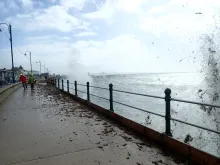Currently 520,000 properties in England are in areas with at least a 0.5% annual risk of coastal flooding and about 7,500km of road and 520km of railway line have a 0.1% or more risk. When we account for climate change and sea level rise it is clear that the country needs to better prepare for the threat of flooding and coastal erosion. To improve public preparedness we need to raise hazard awareness, and dramatically improve real-time monitoring to optimise existing forecast services and information accessibility. We will use two sea wall study sites (Penzance and Dawlish). Penzance is one of Cornwall’s most famous towns, but wave overtopping causes frequent seafront closure. Dawlish is the sole railway line to the south west of England, often experiencing restrictions or closure due to wave overtopping.
We will demonstrate a new point-of-impact flood hazard nowcasting system to meet national coastal management needs, and will develop a new web service to enable smart monitoring and return of real-time alerts. The system will have the potential to form a low-cost real-time hazard monitoring network able to issue flood alerts to the National Flood Forecasting Service (NFFS) for validation purposes.
The multi-instrument monitoring system will include a new point-of-impact wave, water level, and overtopping (depth, speed and volume) sensor. Inclusion of traditional camera and laser instruments will provide quality assurance. The system will issue real-time flood and near-real-time coastal erosion hazard alerts, while collecting vital data on the interactions between storm conditions (waves and water levels) and the coastal system (beach level). The smart electronics (via the new web service) will: record data when triggered by water level thresholds using the tide gauge network; telemeter processed data; and issue hazard alerts when conditions exceed set thresholds. The web service will also integrate existing but disparate monitoring data into a single accessible source. It will be designed for future interfacing with online services such as satellite navigation systems.
Using self-guided interactive coastal walks the public will be led to CoastSnap posts, an international citizen beach monitoring initiative led locally by our Project Partners. The data gathered will have significant impact for decision-makers, policy-makers and the local coastal communities. The walks will be illustrated by an Augmented Reality (AR) phone application (app), allowing the public to access, interrogate and understand our new and the existing hazard data along with past, current and potential future hazards.
Our objectives are to:
- develop a point-of-impact flood monitoring sensor;
- automate both the new and traditional measurement technologies;
- use the new web service capability to bring together existing but disparate coastal, river and meteorological hazard monitoring with our new data;
- improve existing online hazard modelling services; and,
- engage the public in citizen-led beach monitoring, while raising the profile of existing flood forecasting services.
We aim to:
- develop a versatile, cheap, low-maintenance wave overtopping sensor with on-board data processing and telemetry;
- integrate the new sensor with traditional monitoring equipment into the online SWEEP forecast service;
- deploy the new sensors across the face of the sea wall (for impacting wave and water levels) and above it (for overtopping depths, volumes and speeds);
- develop a new web service to integrate established National Monitoring Networks and expose the data to the SWEEP forecast service;
- incorporate the data into an AR coastal walk designed with the local community; and,
- market and launch the phone app and CoastSnap initiative with local councils and National rail to engage the public in flood and coastal erosion hazard management.





